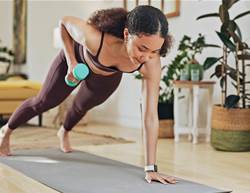My husband thought Aqua Sculpt might have something to do with a large high-pressure hose being pointed at my body for some sort of weight-loss benefit. Thankfully, it doesn’t. Instead, it’s what happens when you take a Pilates or yoga class and level it up with a mat floating in a pool. Despite being somewhat nervous that my latent clumsiness would lead me astray, I gave the Pilates class a go.
What is Aqua Sculpt?
Think floating Pilates or yoga. You do the class on a thick floating mat, almost like a hard lilo. It’s not as unstable as it sounds as the mat is hooked onto pool lane dividers. However, it is still wobbly, especially when you’re standing. As you have to wade into the pool to set up your mat, you are wet before you start. So, it’s best to wear swimmers rather than activewear.
The instability of the mat means you’re working your core throughout the class, just like you do on an exercise ball.
Only one company is doing this sort of exercise in Australia, and it runs in two locations in Sydney. Founder Nina Hirschfeld was inspired to start the company after trying a float fitness HIIT class on holiday in Dubai.
“I loved that it was fun, playful, using water to transform the body and the suspense of maybe falling created an exhilarating experience.
“It was such a refreshing departure from the typical gym routine, and I knew that others would enjoy it as much as I did,” she says.
What are the benefits of Pilates?
Pilates uses a combination of repetitive exercises to work your muscles. Classes can range from gentle strength training or injury rehabilitation to vigorous workouts for only the fittest people. Pilates is designed to “increase muscle strength and endurance, as well as flexibility and to improve posture and balance”, reports health researcher and Pilates teacher June Kloubec in the Muscle, Ligaments and Tendons Journal. There’s not a lot of scientific research backing up the benefits of Pilates, but the research done so far is promising.
The two main forms are mat Pilates and reformer Pilates. Pool Pilates is a new twist on the popular exercise.
Hirschfield says the benefits range from improved balance and concentration to muscle gains.
“Exercising on top of the water with the added balance component requires more effort from muscles to perform various poses and exercises. This engagement strengthens and tones multiple muscle groups simultaneously, including core muscles.”
The verdict?
I had visions of becoming a meme. A 30-something woman tries a new pool-based exercise requiring balance and fails spectacularly. Someone secretly films it and the whole internet laughs. I also half expected this class to be one of those pointless fitness trends that tries something new for the sake of it, with little benefit; the exercise equivalent of a one-hit-wonder. But I enjoyed it much more than I expected.
First, it was accessible even for someone like me with a bunch of injuries as it’s low impact – no jumping or running.
Second, it was a balance challenge in a fun way. I had a few hairy moments of wobble but didn’t fall in. And let’s face it, if I had fallen in, as I was already wet it wouldn’t have been the dramatic fail I was imagining. I also liked the concentration required for the class. My mind wasn’t wandering as I was focused on not falling in the pool.
Hirschfield provided easy and hard options for several of the exercises and for my first class I took it easy. In future classes I could do the harder options and the challenge would increase as I gained confidence.
The vibe of the pool Pilates class was excellent. Founder and instructor Hirschfield was friendly and encouraging. It was a small class, too, with none of the intimidating vibe of some hard-core Pilates studios.
“My aim has consistently been to cultivate an environment that is welcoming, sociable, and infused with a sense of playfulness,” says Hirschfield.
All round, it was a fun and surprisingly effective workout.










